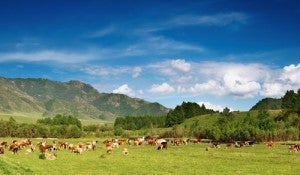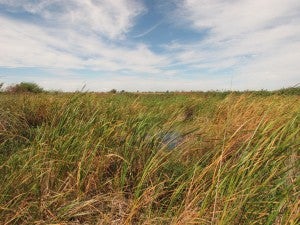Why grasslands can bring in the green for growers
 Rebecca Haynes is a High Meadows Fellow with EDF’s Agriculture Greenhouse Gas Markets program.
Rebecca Haynes is a High Meadows Fellow with EDF’s Agriculture Greenhouse Gas Markets program.
Next week, hundreds of ranchers, landowners, land trusts, and environmental groups will gather in Stockton, California, for the California Rangeland Conservation Coalition’s annual summit. The event isn’t new, but the enthusiasm from attendees is unprecedented and palpable.
Why such a bustle in the grasses? Because of two recent landmark developments that reward ranchers for avoiding the conversion of grasslands to croplands:
- In August, the Climate Action Reserve (one of the offset registries that oversees carbon credit development) approved a new voluntary grasslands protocol that offers payment for conservation activities.
- In September, the Climate Action Reserve received a Conservation Innovation Grant (CIG) from the USDA to create a pilot grasslands project in coordination with EDF. This project will assist participating landowners in generating carbon credits. If adopted by the California Air Resources Board in the future, these credits could be sold in the California cap-and-trade market.
These two developments are part of a rapidly growing trend that offers landowners payments for conservation measures. Protecting grasslands means big wins for the planet and for ranchers, who have been committed partners in conservation and now have the opportunity to receive additional incentives to protect their landscapes. Here’s how it all works.
Grassland benefits
California’s grasslands cover approximately 25 percent of the state – either as open grassland, oak woodland, or savanna. And they provide a lot more than a beautiful landscape. Healthy grasslands support healthy watersheds, improve water quality, and help prevent erosion.
Many of these grasslands also support livestock and other grazing animals, and provide important habitat to numerous endangered and migratory species. Approximately 90 percent of species listed in California’s Inventory of Rare and Endangered Species live within grassland ecosystems.
Over decades, carbon from the atmosphere accumulates in the soil of grasslands, a fantastic way to store the carbon and keep it out of the air. But this carbon is released when the land is converted to cropland, thereby emitting greenhouse gases that contribute to climate change.
How to generate carbon credits
 Ranchers who participate in the pilot project are rewarded for avoided conversion, meaning leaving their grasslands in place. Even though ranchers lose the opportunity to convert their grasslands to cropland, they still benefit financially from the additional revenue earned by keeping carbon in its place – in the soils of their grasslands.
Ranchers who participate in the pilot project are rewarded for avoided conversion, meaning leaving their grasslands in place. Even though ranchers lose the opportunity to convert their grasslands to cropland, they still benefit financially from the additional revenue earned by keeping carbon in its place – in the soils of their grasslands.
Only a few metrics are needed to determine whether a rancher’s land is eligible to participate in the pilot project, and how much revenue he or she could gain from enrollment. These metrics include land use history, geography, and soil type. EDF and our partners will assist with the data collection and registration of the project. The data is then submitted to the Climate Action Reserve and independently verified by a third-party auditor. Once the information is verified, the landowner is issued credits for the carbon kept in their soil.
If you’ll be at the summit in Stockton next week, come by EDF’s booth to learn more about the Grassland Conservation project. I’d love to tell you more. You can also send me an email, or connect with my colleague Robert Parkhurst.













2 Comments
Do you think there will be a program in the future that will allow you to generate carbon credits when you already have an easement that requires it to stay in grasslands but we can show an increase in soil org matter (or in trees etc.) by changing some management practice, like adding compost, planting perennial grasses or plant trees?
Dear Bruce,
Thanks for your comment. This blog post was specifically geared towards landowners who want to place an easement on grasslands and generate carbon credits from the protection of that land. We do anticipate that in the future, landowners with easements will be able to generate environmental credits from implementing additional practices. Here’s a breakdown of some of these upcoming opportunities.
Compost:
In 2014, the American Carbon Registry adopted a protocol that allows for compost applications on rangelands for the generation of carbon credits. This protocol would allow ranchers to account for and generate credits from the additional carbon sequestered as a result of applying compost, even if the landowner already had an easement in place. The protocol is available for use now by interested ranchers.
As a part of the adoption of the protocol, the Marin Carbon Project worked with NRCS to pilot three projects to assess the feasibility of applying compost to rangelands to generate carbon credits and refine the protocol. NRCS is conducting additional research on a variety of soil types, climates, and geographies to determine the applicability of these projects in a range of different conditions across California. Audubon and The Nature Conservancy are also undertaking additional projects in California to investigate how to expand this practice implementation so as not to negatively impact biodiversity and increase habitat.
Planting perennial grasses:
While there isn’t any work right now on carbon credits for the planting of perennial grasses, there may be opportunities for a grassland owner with an easement to generate habitat credits by implementing practices that improve the habitat for listed or endangered species. Landowners who can improve or maintain habitat can sell credits from doing so to developers who need to offset the impacts of their operations. Habitat Exchanges are currently being developed for prairie chicken, sage grouse, Chinook salmon, Swainson’s hawk, and riparian songbirds. See this blog for more information: https://www.edf.org/ecosystems/habitat-exchanges-how-do-they-work
Planting trees:
Landowners may be able to participate in carbon stacking by developing reforestation projects, planting trees, and selling those carbon offset credits on their land. Where land is covered by less than 10% tree canopy, grassland owners can be eligible for projects as long as none of the terms of the grassland conservation easement are invalidated.